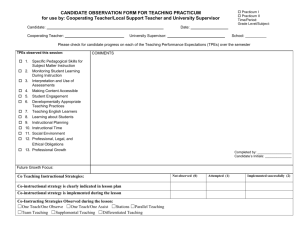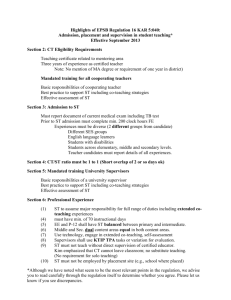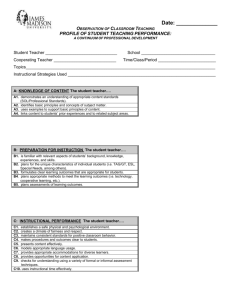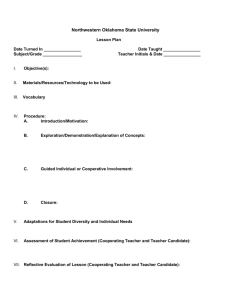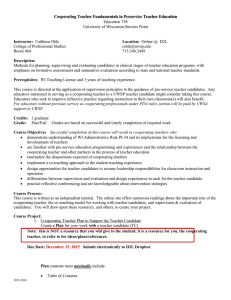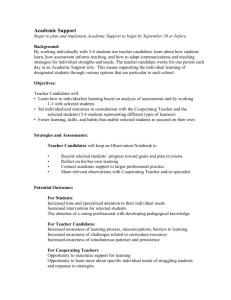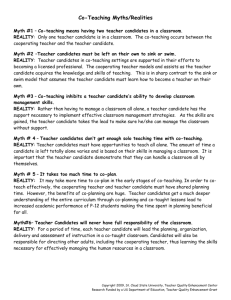Co-Teaching - California State University, Fresno
advertisement
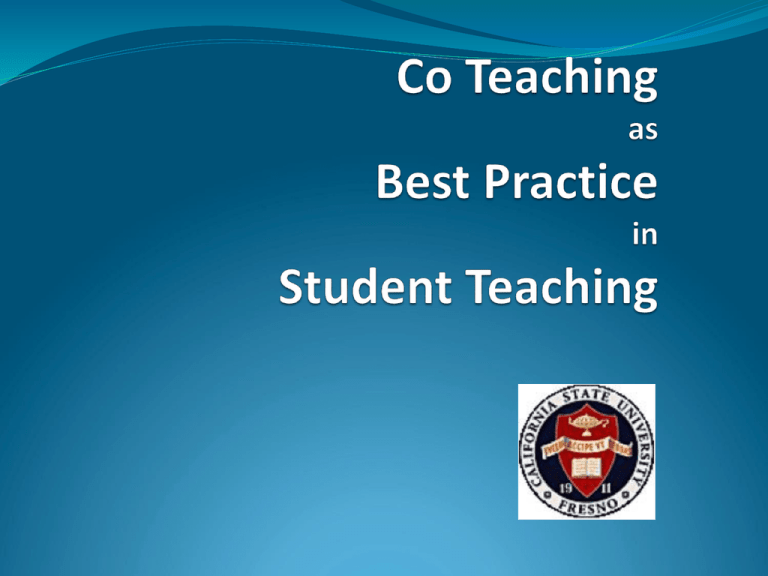
“Coming together is a beginning. Keeping together is progress. Working together is success.” - Henry Ford - Co-Teaching …is defined as two teachers (cooperating teacher and teacher candidate) working together with groups of students - sharing the planning, organization, delivery and assessment of instruction, as well as the physical space. Both teachers are actively involved and engaged in all aspects of instruction Co-Teaching is an Attitude An attitude of sharing the classroom and students Co-Teachers must always be thinking… WE’RE BOTH TEACHING! Participating Districts Spring & Fall 2012 583 Workshop Participants 233 152 56 42 24 21 19 6 5 4 4 4 2 2 2 2 1 1 1 1 1 Special Education 9% Subject Area Single Subject 25% Multiple Subject 66% Administrator 1% University Supervisor 4% Position/Title Teacher Candidate 49% Cooperating Teacher 46% What were some of the benefits to K-12 students? Benefits to K-12 Students Increased student engaged time Able to work in smaller groups Receive more individual attention Get questions answered faster Get papers and grades back faster Students behave better Fewer class disruptions (for passing out papers, having projects checked, other housekeeping tasks) Benefits to Teacher Candidates Increase collaboration skills with cooperating teacher (84.4%) Deeper Understanding of the curriculum (78.6%) More opportunities to ask questions and reflect (78.6%) Benefits to Teacher Candidates Improve classroom management skills (75.7%) Allow more teaching time (72.8%) Increase self-confidence(72.8%) Benefits to Cooperating Teachers Develop better relationship with teacher candidate (89.2%) Reach more students, particularly those with high needs (86.8%) Host a candidate without giving up my classroom (85.6%) Benefits to Cooperating Teachers Allow the TC to have a better experience than through a traditional model (81.9%) Enhance energy for teaching (78.3%) Experience professional growth (71.1%) One Teach, One Observe One Teach, One Assist Station Teaching Parallel Teaching Supplemental Teaching Alternative (Differentiated) Teaching Team Teaching One Teach, One Observe One teacher has primary instructional responsibility while the other gathers specific observational information on students or the (instructing) teacher. One Teach, One Assist One teacher has primary instructional responsibility while the other assists students’ with their work, monitors behaviors, or corrects assignments. Station Teaching The co-teaching pair divide the instructional content into parts. Each teacher instructs one of the groups, groups then rotate or spend a designated amount of time at each station. Example – “Nick had a unit on Statistics and Sampling.” “We set up four stations.” “Students used number cubes to gather data for measures of central tendency.” “There was a group that went to students on campus and used a survey for favorite Dr. Seuss book.” “Another group had a vocab., definition, example match to complete with a partner.” “The final group worked on writing questions for an unbiased questionnaire.” Parallel Teaching In this approach, each teacher instructs half the students. The two teachers are addressing the same instructional material using the same teaching strategies. Supplemental Teaching This strategy allows one teacher to work with students at their expected grade level, while the other teacher works with those students who need the information and/or materials extended or remediated. Example – “We decided to use this with four students who need a little boost and they will be working with the class, but their focus will be Nick’s lesson stretch. The concept we are teaching is Probability and we will be using this for the whole topic. I am teaching and Nick is supplementing. Three days of this have gone very well.” Alternative or Differentiated Teaching • Alternative teaching strategies provide two different approaches to teaching the same information. • The learning outcome is the same for all students however the avenue for getting there is different. Example In a reading/writing activity for EL students: the instruction for the limited English speakers (Level 2) who can produce simple sentences would involve frontloading of the essential vocabulary, sentence frames provided by the teacher to shape the writing and a pre-drawn (connect the dots) graphic organizer visual to generate ideas for writing. For the more fluent English speakers (Level 4) the teacher can read the story and use the Fishbone Graphic Organizer to organize and outline their thoughts for writing production. Team Teaching Well planned, team taught lessons, exhibit an invisible flow of instruction with no prescribed division of authority. Both teachers are actively involved in the lesson. From a student’s perspective, there is no clearly defined leader, as both teachers share the instruction, are free to interject information, and available to assist students and answer questions. Hierarchy???? Team Teaching Alternative or Differentiated Teaching Supplemental/Extended Teaching Parallel Teaching Station Teaching One Teach, One Assist One Teach, One Observe The Student Teaching Triad Teacher Candidate Cooperating Teacher University Supervisor Communication What role does each person play? Reflection “Think Pair Square” Describe how you would integrate these Co-Teaching strategies in your classroom.
